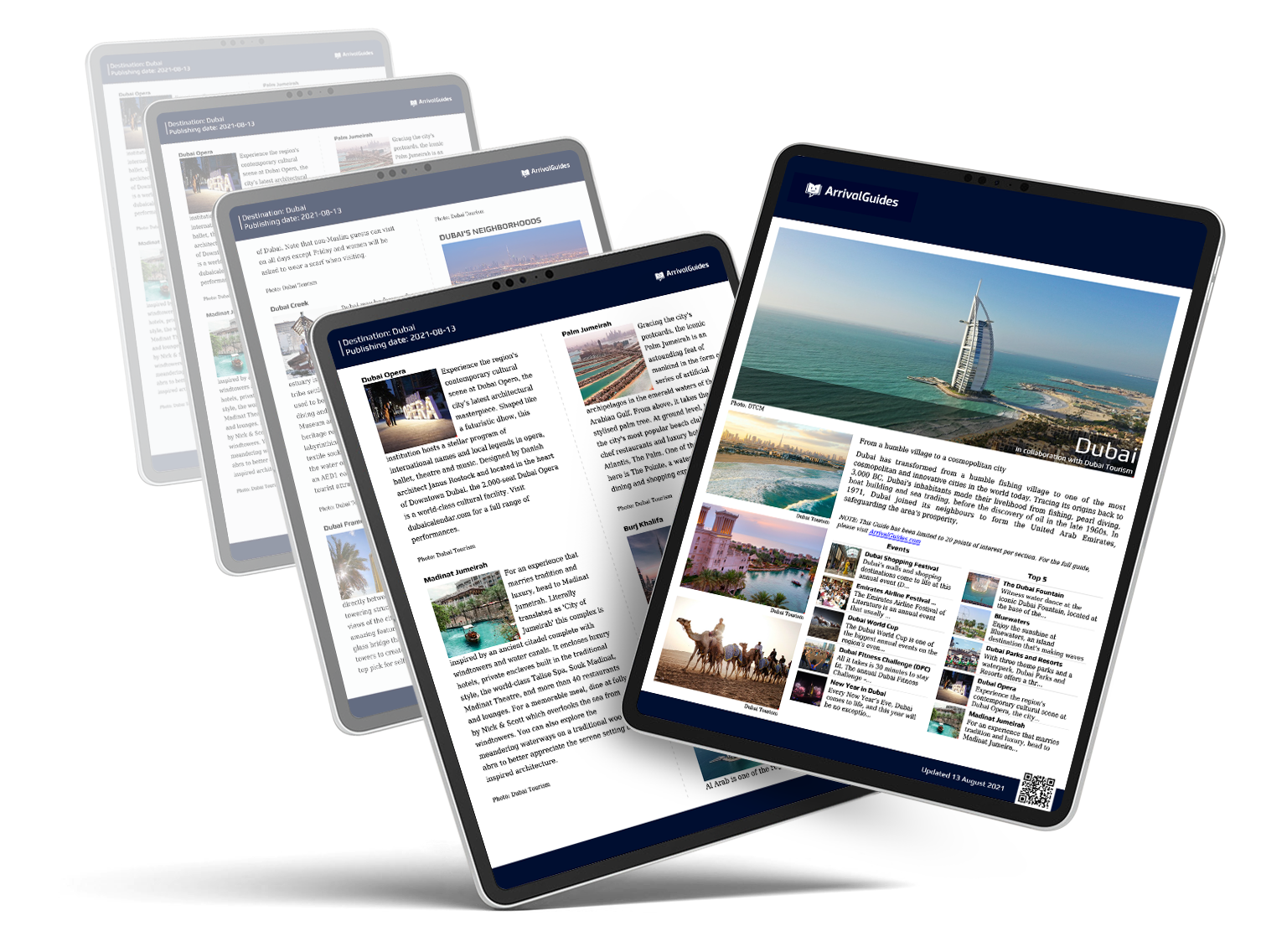
-
![Tunis parked with a red dot on the map of Tunisia]() Provided by: Matheus Obst/shutterstock
Provided by: Matheus Obst/shutterstock

Our travel guides are free to read and explore online. If you want to get your own copy, the full travel guide for this destination is available to you offline* to bring along anywhere or print for your trip.
*this will be downloaded as a PDF.Price
€4,95
Tunis–Carthage International Airport (TUN)
The guide was updated:The Tunis International Airport is conveniently located close to the city centre. A journey to or from the airport should take no more than 20 minutes depending on the traffic.
The airport is served by bus lines and taxis, but not by train.
There are two bus lines connecting Tunis city centre to the airport. SNT buses run at 30-minute intervals with trips costing less than 1 dinar. TUT buses depart more frequently (every 15 minutes) and are more modern and slightly more costly.
Taxis are readily available upon exiting the terminal, but make sure to either agree on the price beforehand or check that the driver uses an official taxi meter prior to departure.
Useful Information
- Address: Aéroport international de Tunis-Carthage, Tunis
- Website: www.aeroport-de-tunis-carthage.com
- Phone: +216 71 754 000
Digital Travel Guide Download
Our travel guides are free to read and explore online. If you want to get your own copy, the full travel guide for this destination is available to you offline* to bring along anywhere or print for your trip.
*this will be downloaded as a PDF.Price
€4,95

The Tunis International Airport is conveniently located close to the city centre. A journey to or from the airport should take no more than 20 minutes depending on the traffic.
The airport is served by bus lines and taxis, but not by train.
There are two bus lines connecting Tunis city centre to the airport. SNT buses run at 30-minute intervals with trips costing less than 1 dinar. TUT buses depart more frequently (every 15 minutes) and are more modern and slightly more costly.
Taxis are readily available upon exiting the terminal, but make sure to either agree on the price beforehand or check that the driver uses an official taxi meter prior to departure.
Read more

Passport & Visa
For stays of up to 90 days, a visa is not required for citizens of 97 world countries, including all citizens of the European Union (except Cyprus), Untied States, Canada, Australia, Russia, and an extensive number of further states. Citizens of Azerbaijan, Belarus, Georgia, Kazakhstan, Kyrgyzstan, Macao, Tajikistan, Turkmenistan, Ukraine and Uzbekistan may only enter visa-free when travelling as part of an organized tour, upon producing a hotel voucher. For updated information at your planned time of travel, please contact an embassy or consulate closest to you.
Read more

Best Time to Visit
For exploring Tunis, spring (April through May) and autumn (September and October) deliver ideal conditions. The weather is warm but not extremely hot, perfect for sightseeing without summer crowds. Winter brings mild, sunny days suited to desert trips, exploring the medina or golfing. February stands out with its crowd-free sights and absence of summer’s heat or insects.
Spring’s greenery makes this season ideal for coastal breaks and water sports. Summer transforms Tunisia into a vibrant seaside escape with lively nights and endless beaches. Autumn balances warm sea swims with desert adventures, followed by spa treatments at Thalasso centres.
Read more

Public Transport
Tunis offers a comprehensive public transport network, including buses, an above-ground light rail system (known as le métro or métro léger), and the TGM (Tunis-Goulette-Marsa) suburban train line linking the city centre to northern suburbs like La Goulette, Sidi Bou Saïd and Carthage. The TGM provides affordable, frequent service with scenic coastal views. Note that some stations don't have ticket offices, so buying tickets in advance helps.
For budget-friendly travel, buses operated by Transtu cover urban and suburban routes. You can buy tickets at stops or onboard, but be prepared for crowds during peak hours.
To experience transport like a local, try shared louage taxis. These minivans, similar to Turkey’s "dolmuş" and Latin American "colectivo", depart when full and offer faster, more flexible trips than buses, even to destinations beyond the city.
Read more

Taxi
Yellow cabs that circulate around the city usually run with a taxi meter, but make sure that your driver turns it on before starting the journey. Oddly, the taxis with a red light on are free to be hailed, while a green light means the cab is occupied.
If the taxi you decide to use does not have a meter, make sure to agree on the price to your destination before getting in.
Payments are cash only.
Uber and Lyft are not available in Tunisia. Bolt, another ride-hailing app, suspended its operations in May 2025.
Read more

Post
There are several post offices located around the city. You'll find a big post office in the city centre on rue Charles de Gaulle. There's also a small branch at the airport in case you want to send some last-minute postcards.
Read more

Pharmacy
Pharmacies, usually marked by green neon signs spelling “Pharmacie”, are ubiquitous in Tunis. While most close by evening, each displays the address of the nearest night pharmacy on its door — typically one per district. Note that French-speaking staff are common, but it’s wise to know your medication’s generic name. For minor ailments, pharmacists can prescribe treatments directly, saving clinic visits.
Read more

Electricity
Tunisia’s electrical system operates at 230 volts with a frequency of 50 Hz. Power sockets are Type C (two round pins) and Type E (two round pins with an earthing socket).
Read more

Phone
Country code 216 followed by an 8-figure number.
Area codes for Tunis: 70, 71 and 79.
Read more


